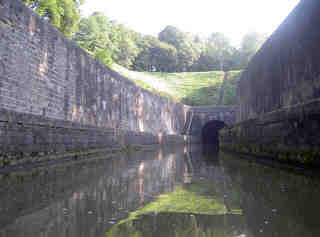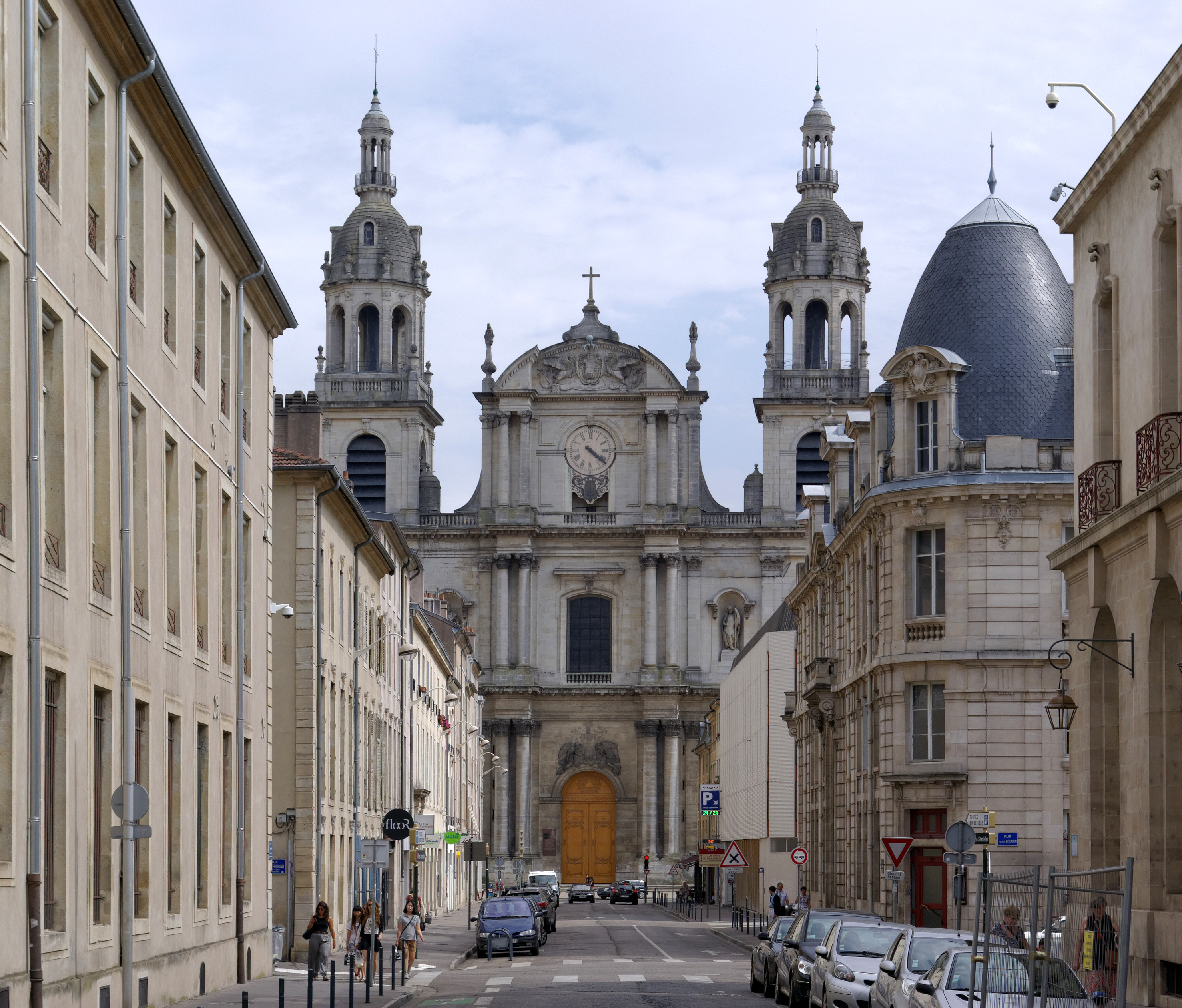|
Paris-Est–Mulhouse-Ville Railway
The railway from Paris-Est to Mulhouse-Ville is a 491-kilometre long railway line, that connects Paris to Mulhouse via Troyes, Chaumont and Belfort, France. The railway was opened in several stages between 1848 and 1858. Route The Paris–Mulhouse railway leaves the Gare de l'Est in Paris in eastern direction. At Noisy-le-Sec, where the Paris–Strasbourg railway branches off, it turns south. It crosses the river Marne at Nogent-sur-Marne, and turns southeast. Near Gouaix it reaches the river Seine, and follows this river upstream, until Nogent-sur-Seine on its right bank, then on its left bank, roughly southeastward. At Troyes it crosses the Seine again, and turns east. It enters the Aube valley near Jessains, and continues upstream along Bar-sur-Aube. It leaves the Aube and enters the upper Marne valley at Chaumont. It passes Langres and the railway junction Culmont-Chalindrey, where it crosses the line Nancy–Dijon. It reaches the river Saône at Jussey, and follows ... [...More Info...] [...Related Items...] OR: [Wikipedia] [Google] [Baidu] |
Longueville, Seine-et-Marne
Longueville () is a Communes of France, commune in the Seine-et-Marne Departments of France, department in the Île-de-France Regions of France, region in north-central France. Longueville station has rail connections to Provins, Chaumont, Troyes, Mulhouse, Dijon and Paris. Demographics The inhabitants are called the ''Longuevillois''. See also *Communes of the Seine-et-Marne department References External links 1999 Land Use, from IAURIF (Institute for Urban Planning and Development of the Paris-Île-de-France région) * Communes of Seine-et-Marne {{Provins-geo-stub ... [...More Info...] [...Related Items...] OR: [Wikipedia] [Google] [Baidu] |
Saône
The Saône ( , ; ; ) is a river in eastern France (modern Regions of France, region of Bourgogne-Franche-Comté). It is a right tributary of the Rhône, rising at Vioménil in the Vosges (department), Vosges Departments of France, department and joining the Rhône in Lyon, at the southern end of the Presqu'île. Terminology The name derives from that of the Celtic mythology, Gallic river goddess Souconna (mythology), Souconna, which has also been connected with a local Celts, Celtic tribe, the Sequani, Sequanes. Monk, Monastic copyists progressively transformed ''Souconna'' to ''Saoconna'', which ultimately gave rise to . The other recorded ancient names for the river were and . The name ''Arar'' later gave rise to specific regional terms in historiography, created to designate various northern parts of History of Burgundy, historical Burgundy in relation to the river Saône. Depending on the point of view of a particular author, northern Burgundian lands were thus designated ... [...More Info...] [...Related Items...] OR: [Wikipedia] [Google] [Baidu] |
Dijon
Dijon (, ; ; in Burgundian language (Oïl), Burgundian: ''Digion'') is a city in and the Prefectures in France, prefecture of the Côte-d'Or Departments of France, department and of the Bourgogne-Franche-Comté Regions of France, region in eastern France. the Communes of France, commune had a population of 156,920. The earliest archaeological finds within the city limits of Dijon date to the Neolithic Period (geology), period. Dijon later became a Roman Empire, Roman settlement named ''Divio'', located on the road between Lyon and Paris. The province was home to the Duke of Burgundy, Dukes of Burgundy from the early 11th until the late 15th centuries, and Dijon became a place of tremendous wealth and power, one of the great European centres of art, learning, and science. The city has retained varied architectural styles from many of the main periods of the past millennium, including Capetian, Gothic architecture, Gothic, and Renaissance architecture, Renaissance. Many still-i ... [...More Info...] [...Related Items...] OR: [Wikipedia] [Google] [Baidu] |
Nancy, France
Nancy is the Prefectures in France, prefecture of the northeastern Departments of France, French department of Meurthe-et-Moselle. It was the capital of the Duchy of Lorraine, which was Lorraine and Barrois, annexed by France under King Louis XV in 1766 and replaced by a Provinces of France, province, with Nancy maintained as capital. Following its rise to prominence in the Age of Enlightenment, it was nicknamed the "capital of Eastern France" in the late 19th century. The metropolitan area of Nancy had a population of 508,793 inhabitants as of 2021, making it the 16th-largest functional area (France), functional urban area in France and Lorraine's largest. The population of the city of Nancy proper is 104,387 (2022). The motto of the city is —a reference to the thistle, which is a symbol of Lorraine. Place Stanislas, a large square built between 1752 and 1756 by architect Emmanuel Héré under the direction of Stanislaus I of Poland to link the medieval old town of Nancy and ... [...More Info...] [...Related Items...] OR: [Wikipedia] [Google] [Baidu] |
Gare De Culmont-Chalindrey
Gare is the word for "station" in French and related languages, commonly meaning railway station Gare can refer to: People * Gare (surname), surname * The Gare Family, fictional characters in the novel '' Wild Geese'' by Martha Ostenso Places * Gare, Zavidovići, Bosnia and Herzegovina * Gare (Gadžin Han), a village situated in Gadžin Han municipality in Serbia * Garé, Hungary * Gare, Luxembourg, neighborhood around the railway station in Luxembourg City, Luxembourg * Gare Loch, an open see loch in Argyll and Bute, Scotland * Pompoï-gare, Pompoï-gare is a village in the Pompoï Department of Balé Province in southern Burkina Faso * South Gare, an area of reclaimed land and breakwater on the southern side of the mouth of the River Tees in Redcar and Cleveland, England ** South Gare & Coatham Sands SSSI, Site of Special Scientific Interest ** South Gare Lighthouse, at the end of the South Gare breakwater Transportation ''Gare'' refers to many stations in Francophone and o ... [...More Info...] [...Related Items...] OR: [Wikipedia] [Google] [Baidu] |
Langres
Langres () is a commune in France, commune in northeastern France. It is a Subprefectures in France, subprefecture of the Departments of France, department of Haute-Marne, in the Regions of France, region of Grand Est. History As the capital of the Romanized Gauls, Gallic tribe known as the Lingones, it was called Andematunnum, then Lingones, and now Langres. A hilltop town, Langres was built on a limestone promontory of the same name. This stronghold was originally occupied by the Lingones. At a later date the Romans fortified the town, which they called Andemantunum, located at a strategic crossroads of twelve Roman roads. The first-century Triumphal Gate and the many artefacts exhibited in the museums are remnants of the town's Gallo-Roman history. After the period of invasions, the town prospered in the Middle Ages, due in part to the growing political influence of its bishops. The diocese covered Champagne (province), Champagne, the Duchy of Burgundy, and Franche-Comté, ... [...More Info...] [...Related Items...] OR: [Wikipedia] [Google] [Baidu] |
Bar-sur-Aube
Bar-sur-Aube (, literally ''Bar on Aube (river), Aube'') is a Communes of France, commune and a Subprefectures in France, sub-prefecture in the Aube Departments of France, department in the Grand Est region of France. Surrounded by hills and Champagne vineyards, the city is traversed by the river Aube, from which it derives its name. The inhabitants of the commune are known as ''Baralbins'' or ''Baralbines'' and ''Barsuraubois'' or ''Barsurauboises''. The commune has been awarded three flowers by the ''National Council of Towns and Villages in Bloom'' in the ''Competition of cities and villages in Bloom''. Geography Bar-sur-Aube is located some 30 km west by north-west of Chaumont, Haute-Marne, Chaumont and 25 km south-east of Brienne-le-Château. Access to the commune is by the D619 road from Ailleville in the north-west which passes through the centre of the commune and the town before continuing east to Lignol-le-Château. The D396 branches off the D619 south-ea ... [...More Info...] [...Related Items...] OR: [Wikipedia] [Google] [Baidu] |
Jessains
Jessains () is a commune in the Aube department in north-central France. Population See also *Communes of the Aube department *Parc naturel régional de la Forêt d'Orient Orient Forest Regional Natural Park ( French: ''Parc naturel régional de la Forêt d'Orient'') is a protected area of woodlands and lakes in the Champagne-Ardenne region of France. It covers a total area of The parkland encompasses the large F ... References Communes of Aube Aube communes articles needing translation from French Wikipedia {{BarAube-geo-stub ... [...More Info...] [...Related Items...] OR: [Wikipedia] [Google] [Baidu] |
Aube (river)
The Aube () is a river in France, a right tributary of the Seine. It is long. The river gives its name to the Aube department. Its source is in the Haute-Marne department, on the plateau of Langres, near the town of Auberive. It flows through the departments of Haute-Marne, Côte-d'Or, Aube, and Marne. It flows into the river Seine near Marcilly-sur-Seine. Cities along the river include Bar-sur-Aube and Arcis-sur-Aube. Main tributaries * Aubette * Aujon * Landon * Voire * Ravet * Meldançon * Puits * Huitrelle * Herbissonne * Barbuise * Salon * Superbe Departments and towns crossed * Haute-Marne: Auberive * Côte-d'Or: Montigny-sur-Aube * Aube: Bar-sur-Aube, Brienne-le-Château, Ramerupt, Arcis-sur-Aube * Marne: Anglure See also * The Albian Age in the Cretaceous Period of geological time is named for the River Aube (after the Latin name for the river, Alba) * Rivers of France This is a list of rivers that are at least partially in France. The ri ... [...More Info...] [...Related Items...] OR: [Wikipedia] [Google] [Baidu] |
Nogent-sur-Seine
Nogent-sur-Seine () is a commune in the Aube department in north-central France. The headquarters of The Soufflet Group is located here, as is the Musée Camille Claudel. The large Nogent Nuclear Power Plant is also located here. Population Personalities Sculptor Camille Claudel lived in Nogent-sur-Seine with her family from 1876 to 1879. Frédéric Moreau, the hero of Gustave Flaubert's novel '' Sentimental Education,'' is a native of Nogent-sur-Seine. The abbey of Nogent-sur-Seine was destroyed during the French Revolution. Fragments of it were used in 1817 in making the canopy over the graves of Pierre Abélard and Héloïse d'Argenteuil at the Père Lachaise Cemetery. International relations Nogent-sur-Seine is twinned with: * Rielasingen-Worblingen, Baden-Württemberg, Germany - since 1973 * Joal-Fadiouth, Senegal - 1987 See also * Communes of the Aube department * List of medieval bridges in France A list is a set of discrete items of information ... [...More Info...] [...Related Items...] OR: [Wikipedia] [Google] [Baidu] |
Seine
The Seine ( , ) is a river in northern France. Its drainage basin is in the Paris Basin (a geological relative lowland) covering most of northern France. It rises at Source-Seine, northwest of Dijon in northeastern France in the Langres plateau, flowing through Paris and into the English Channel at Le Havre (and Honfleur on the left bank). It is navigable by ocean-going vessels as far as Rouen, from the sea. Over 60 percent of its length, as far as Burgundy (region), Burgundy, is negotiable by large barges and most tour boats, and nearly its whole length is available for recreational boating; Bateaux Mouches, excursion boats offer sightseeing tours of the river banks in the capital city, Paris. There are 37 List of bridges in Paris#Seine, bridges in Paris across the Seine (the most famous of which are the Pont Alexandre III and the Pont Neuf) and dozens List of crossings of the River Seine, more outside the city. A notable bridge, which is also the last along the course of ... [...More Info...] [...Related Items...] OR: [Wikipedia] [Google] [Baidu] |





